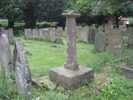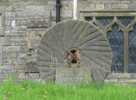For this church:    |
Laxton St MichaelChurchyard
A near-rectangular churchyard with burials on all sides ranging from the 18th centuryonwards. The church is offset to the west side of the yard, and it may be that it has been extended to the east at some point. The churchyard is bounded by a stone wall to the north, where it abuts the main road, to the east and to the west. The south side has a fence. There are buildings to the east and west and a field to the south which contains a bowl barrow (late Neolithic or Bronze Age), a Scheduled Ancient Monument. A geophysical (resistivity) survey undertaken in the 1980s revealed a spread of building debris to the north side of the church, most probably associated with the works of restoration in the 19th century. Also in the churchyard is the cross, which is Listed Grade II. It is of stepped form and is medieval in date. It includes a base consisting of a plinth and one step, a socket stone, a shaft and the remains of a moulded knop. The step is square in plan and constructed of sandstone blocks resting on a plinth which is 2m square. The socket stone stands on the step and is approximately 0.75m square in plan and stands to a height of 0.28m. Set into this socket stone is a 1.2m high stone shaft of square section at its base with chamfered edges tapering upwards to a circular section. Surmounting the shaft is a moulded knop to which the cross head would have originally been attached but this is now missing. The surviving height of the cross and step is 1.8m. Amillstone has also been set up as a celebration of the Queen’s Silver Jubilee. There is a further millstone near the main south entrance to the church. The oldest grave markers are to the south of the church, but they are so badly weathered than they cannot easily be read. |







